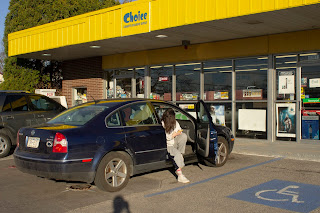Emily Watkins Paragraphs
Cindy Sherman is an American photographer best known for her
conceptual portraits. The most important thing you need to know about Sherman
is that she photographs herself as the character to all of her photographs. She
uses herself to portray identity stereotypes. She focused a lot on the lighting
of the photos and the facial expression. This is evident in her photos, for
example, the book I picked up “Early Work of Cindy Sherman,” she is very obvious
about the shadows she wants, where she wants them and also the expressions on
the characters tell a lot about who they are. This book is a series of “bus
rider” depictions. Many of her early works were in black and white and with
very minimalistic backgrounds. Cindy Sherman process includes setting up the scene,
dressing
up as the character, and to changing the external elements until she is satisfied. I believe I could replicate her work by posing for all 10 photos (myself), dressing up in different outfits
that highlight what type of character I am trying to portray. All I would need
is a white wall with a chair and a couple props. She uses black and white
photography which I would also use. Right now I am thinking I would do the subject "students" and highlight the stereotypical student.
Andrew Cross is a English photographer who is mainly known
for his photography of railroads and highways. Cross uses a wide-angle lens to
capture many landscape scenes. The book I picked up about him, “Along Some
American Highways,” showcases many wide-angle landscape photographs of places
along the interstate highway. Andrew Cross photographs the highway because the
highway system is the thread that unites the states of America and he believes these
spaces should be looked at in a new way. His approach is the approach of a "travelers glance" at places like fast food stops, intersections, highway exits, truck stops, and more. The best way to put it is that he creates
a new reality of the “American traveler.” I read that "The travel is as much about the places the traveler stops at as it is the road" I think that is a very interesting aspect to this photography. I enjoy his approach to a subject that most people don’t
find interesting. A highway is something you don’t appreciate or spend much
time looking at, but it's something we experience all the time. A highway serves to most of us as a convenient way to travel, but there is so much more about it than that. The photographs become a way to view the American experience when on a high speed highway, provoking emotion while doing so. There is a special stillness to these photographs, making the viewer stop and engage with the image. To replicate
this style, I would go explore the highway and find interesting angles and
things to photograph while appreciating and taking it in instead of driving
right past it all.
Kelly Wood is a Canadian photographer whose photography
highlights the environmental impact of waste accumulation, pollution, etc. “The
Continuous Garbage Project” is her most well-known work and it includes a
series of photographs of the waste she created for a five year period. She
explored craft a lot while photographing these which is clear because of how
clean the trash actually looks. All of the trash is tightly secured into a bag.
This transforms the garbage into a work of art. She says the trash she sees is
screaming, “take me away,” and you can feel that through her photography. You
just want to pick up the trash and throw it out. In a specific part within this series, Kelly photographs black garbage bags. The whole idea is deciding whats inside them? Who knows. I could see myself recreating
this by going around state college and photographing dumpsters. Or, another approach is using different types of trash bags that accumulated in my apartment. From boxes, to paper bags, to plastic bags; all the waste that builds up within different cases. I think that
could be an interesting take to this “continuous garbage project.”



Comments
Post a Comment